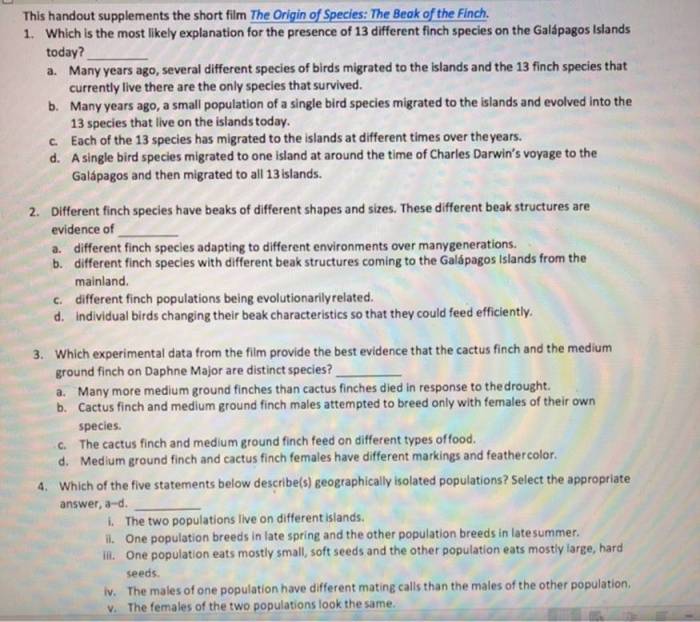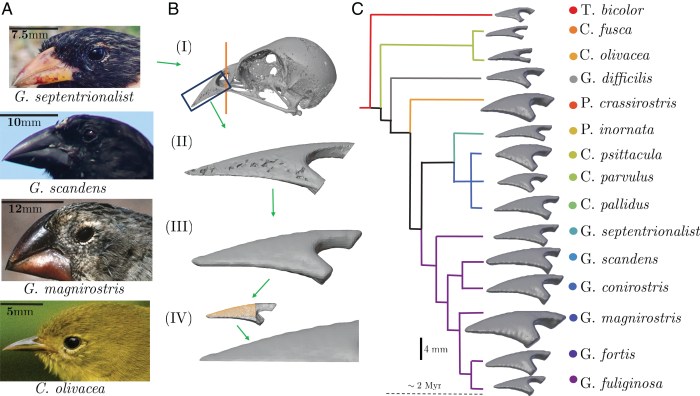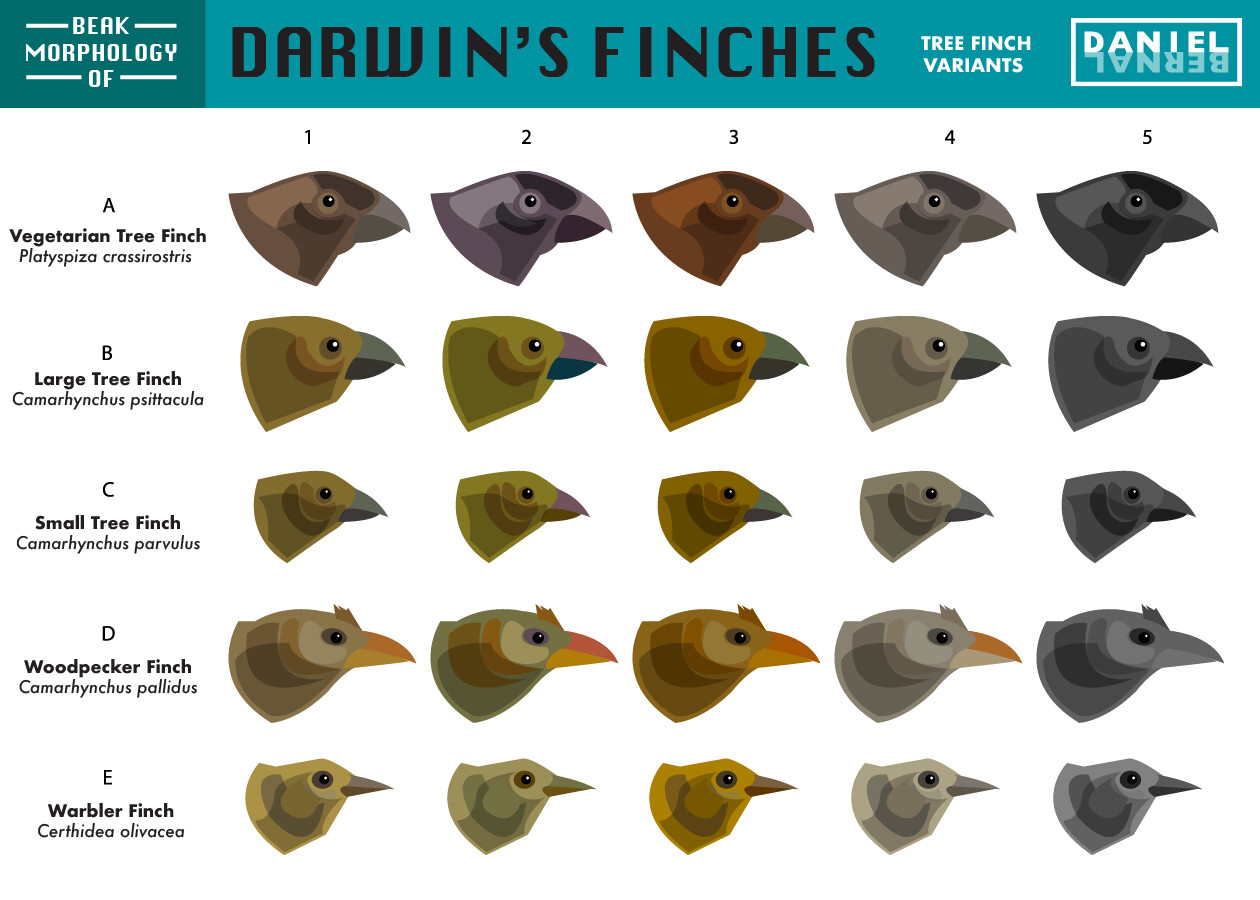The Beak of the Finch Answers embarks on an enthralling exploration of the evolutionary significance of beak morphology, delving into the intricate interplay between natural selection, ecological interactions, genetics, and paleontology. Prepare to be captivated as we uncover the remarkable story of how the beak of the finch has shaped the destiny of this iconic species.
From the Galapagos Islands to the depths of evolutionary history, this discourse unravels the mysteries of beak adaptation, providing profound insights into the intricate dance between form and function.
The Evolutionary Significance of Beak Morphology

Beak morphology, the shape and structure of a bird’s beak, is a fascinating example of how natural selection can drive the evolution of a species. The diversity of beak shapes among different bird species reflects the wide range of food sources they have adapted to exploit.
One of the most striking examples of this is the Galapagos finches studied by Charles Darwin. Darwin observed that different species of finches on different islands had beaks that were specifically adapted to the food sources available on each island.
For example, ground finches with large, strong beaks were able to crack open tough seeds, while tree finches with long, slender beaks were adept at extracting insects from crevices in trees.
Natural Selection and Beak Diversity
The different beak shapes of Galapagos finches are the result of natural selection. Over time, finches with beaks that were better suited to the available food sources were more likely to survive and reproduce. This led to a gradual change in the average beak shape of the population, as finches with less suitable beaks were less likely to pass on their genes.
Implications for Population Genetics and Speciation
Beak morphology can also have implications for population genetics and speciation. For example, if a population of birds becomes isolated from the main population, they may experience different selective pressures. This can lead to the evolution of different beak shapes in the isolated population, which can eventually lead to speciation.
Beak Adaptation and Ecological Interactions

The beak morphology of finches plays a crucial role in their ecological interactions, influencing foraging behavior, competition, and predator-prey dynamics.
Finches exhibit a wide range of beak shapes and sizes, adapted to specific food sources and feeding techniques. For example, ground finches possess robust beaks for cracking seeds, while tree finches have slender beaks for probing flowers and extracting nectar.
Foraging Behavior
Beak morphology directly impacts foraging behavior and diet. The size and shape of a finch’s beak determine the types of food it can access and manipulate. Ground finches with strong beaks can crack hard seeds, while tree finches with thin beaks can extract nectar from flowers.
Competition and Niche Partitioning, The beak of the finch answers
Beak morphology influences competition among finch species. Finches with similar beak shapes and sizes compete for the same food resources. To avoid competition, different finch species have evolved distinct beak morphologies, allowing them to exploit different niches and minimize overlap in their diets.
Exploring the fascinating adaptations of the finch’s beak provides insights into evolutionary processes. If you’re seeking further knowledge, cable restraint classes in pa offer valuable information on animal behavior and training techniques. Returning to our topic, the beak of the finch answers questions about natural selection and the role of environmental pressures in shaping species diversity.
Predator-Prey Dynamics
Beak morphology can also influence predator-prey interactions. Finches with strong beaks may be better equipped to defend themselves against predators, while those with smaller beaks may be more vulnerable to predation.
Beak Development and Genetics
The beak of a finch is a complex structure that is essential for the bird’s survival. The shape of the beak is determined by a combination of genetic and environmental factors.
Genetic Factors
The genes that control beak morphology are located on several different chromosomes. These genes code for proteins that are involved in the development of the beak. Some of these proteins are responsible for the overall shape of the beak, while others are responsible for the size and shape of the individual beak parts.
Environmental Factors
The environment can also play a role in beak morphology. For example, the availability of food can affect the size and shape of the beak. Birds that live in areas with a lot of hard-shelled food will have larger and stronger beaks than birds that live in areas with a lot of soft food.
Molecular Mechanisms Underlying Beak Development
The molecular mechanisms underlying beak development are complex and not fully understood. However, it is known that several different genes are involved in the process. These genes code for proteins that are involved in the formation of the beak bones, the beak muscles, and the beak feathers.
Potential for Artificial Selection to Modify Beak Shape
Artificial selection is a process by which humans breed animals or plants for specific traits. This process has been used to modify the beak shape of finches in captivity. For example, breeders have been able to create finches with beaks that are longer, shorter, wider, or narrower than the beaks of wild finches.
Beak Morphology and Paleontology

The fossil record provides valuable insights into the evolutionary history of beak morphology in finches. By examining the beak shapes of extinct and extant species, paleontologists can trace the evolution of these structures and infer past environmental conditions.
Fossil Record and Beak Evolution
- The fossil record shows a gradual diversification of beak shapes in finches over time, reflecting their adaptation to different ecological niches.
- Extinct finch species often exhibit beak morphologies that differ from those of modern species, suggesting that beak shape has undergone significant evolutionary change.
- By comparing the beak shapes of extinct and extant species, paleontologists can identify the selective pressures that have shaped beak evolution.
Implications for Past Environmental Conditions
Beak morphology can provide clues about past environmental conditions. For example, the presence of finches with large, robust beaks in the fossil record may indicate a diet of hard seeds, while finches with small, delicate beaks may have specialized in eating insects.
- By studying the beak morphology of extinct finches, paleontologists can reconstruct the types of food resources available in past ecosystems.
- Changes in beak morphology over time can reveal shifts in environmental conditions, such as changes in vegetation or climate.
- Beak morphology can also provide insights into the competitive interactions between different finch species in the past.
Beak Morphology and Conservation: The Beak Of The Finch Answers

Beak morphology provides valuable insights into the health and resilience of finch populations. Variations in beak shape reflect adaptations to specific ecological niches, influencing foraging success, reproductive fitness, and overall population dynamics.
Implications for Conservation
Conservation efforts can benefit from considering beak morphology. Species with specialized beaks adapted to unique food sources may be more vulnerable to habitat loss or resource depletion. Conversely, species with generalized beak shapes may have greater adaptability and resilience in changing environments.
Monitoring beak morphology over time can help assess the impact of environmental stressors on finch populations. Changes in beak size, shape, or wear patterns can indicate nutritional deficiencies, habitat degradation, or other factors affecting population health.
Recommendations for Protection
- Protect habitats that support finch species with unique beak morphologies.
- Monitor beak morphology as an indicator of population health and resilience.
- Implement conservation strategies that mitigate threats to finch habitats and food sources.
FAQ
What factors influence beak morphology in finches?
Beak morphology in finches is shaped by a complex interplay of genetic and environmental factors, including natural selection, diet, and developmental constraints.
How does beak shape impact foraging behavior in finches?
Beak shape plays a crucial role in foraging behavior, influencing the types of food sources that finches can access and exploit.
What is the significance of beak morphology in finch speciation?
Beak morphology has been a key driver of speciation in finches, contributing to the diversification of species and their adaptation to different ecological niches.